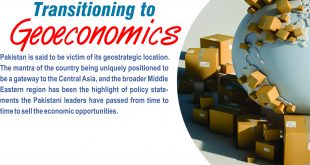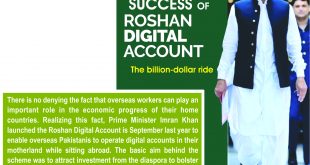Napoleon once said, “If you know a country’s geography, you can understand and predict its foreign policy.” He was dead right as the geostrategic, geopolitical and geoeconomic factors have, indubitably, always played a pivotal role in bringing states together so as to maximise their socioeconomic and security interests. On the same line, both Pakistan and Iran, owing to their geographical contiguity and long-lasting religious, political and cultural ties, share a raft of convergent economic interests and are also facing the same security challenges in the region.
After its historic Nuclear Deal with P5+1, the energy-rich Iran is projected to rise economically and, therefore, become a commanding military power in the oil-rich Gulf region. If Tehran is included in the grand China-Pakistan Economic Corridor (CPEC), bilateral trade between Pakistan and Iran and meaningful security cooperation between the two countries will be on an upward trajectory. More importantly, closer Pak-Iran ties will enormously help Pakistan and China to safeguard CPEC from the disruptive and obstructive designs of India along with the US.
The crushing economic sanctions on Iran have scuttled its economic growth by effecting growing imbalance in its trade, sky-rocketing inflation, double-digit unemployment and, above all, economic stagnation. In the same way, crippling military sanctions have hindered Iran from modernising its aviation and defence sectors. However, this situation has dramatically changed in the post-sanctions period. After having circumscribed its clandestine nuclear programme, the US, the UNSC and the EU have continued to lift economic sanctions they had imposed on Iran.
In the post-sanctions era, Iran has received its frozen money and is surrounded by a slew of economic opportunities to revivify its economy while also increasing its military footprint in the region. On the other side, Pakistan’s economy has also started growing due to over $50 billion investment by China in its rail and road infrastructure, energy sector, etc. Besides, Pakistan Army has been ranked as the 11th strongest military in the world, as per a Credit Suisse report on globalisation. The indigenous production of sophisticated aircraft such as JF-17 Thunders and Al-Khalid tanks in collaboration with China has greatly added to the military prowess of Pakistan. Now, this is the opportune time for Tehran and Islamabad to cultivate and foster robust economic and defence ties.
A Historical Overview
After the establishment of Pakistan, Iran was not only the first state that extended recognition to the new sovereign state, but the Shah of Iran was also the first head of state to visit Pakistan, in March 1950. The visit of the Shah was precipitated by the May 1949 visit of Pakistan’s Prime Minister Liaquat Ali Khan to Iran. To further solidify their relations, Prime Minister Liaquat Ali Khan and the Shah of Iran concluded a treaty of friendship in May 1950.
To boost economic ties, both the countries granted the Most-Favourite Nation (MFN) status to each other; the Shah also offered Iranian oil and gas to Pakistan on generous terms. The MFN status tremendously helped Pakistan and Iran in increasing the level of bilateral trade because a significant number of economic barriers, such as tariffs and restrictions, were eased.
Bilateral relations further cemented when both countries jumped into the American security bandwagon by joining the Central Treaty Organization (CENTO). According to some noted historians, Pakistan joined this organisation owing to the insistence of Iran. In his book “The Frontiers of Pakistan,” Iranian scholar Dr Mujtaba Razvi noted that Pakistan would not have joined CENTO had Iran not decided to do so. This makes it abundantly clear that Tehran and Islamabad had convergent security objectives in the region, and they were inclined to attain them in collaboration with each other.
For regional connectivity and expansion in trade, they formed, along with Turkey, an organization named Regional Cooperation for Development (RCD), which later was transformed into a larger group known as the Economic Cooperation Organization (ECO). Though this bloc has not made significant economic strides, mainly due to lack of interest, it has somehow helped these three nations to come closer to one other in terms of exchanging cultural activities and extending political and diplomatic supports to one another, whenever needed.
Iran extended all-out financial and military assistance to Pakistan whenever the latter badly needed it, especially during wars with belligerent India. Iran played an important role in the Indo-Pak war of 1965 by reportedly providing Pakistan with ninety Sabre jet fighter planes, medics, medical supplies and a gift of 5,000 tonnes of petroleum. Again, Tehran played a vital role in Pakistan’s 1971 conflict with India; this time supplying military equipment as well as diplomatic support.
The two countries also supported each other in countering insurgent movements across the border. When sophisticated arms and ammunition had been discovered in the Iraqi embassy in Islamabad, the then-President Zulfikar Ali Bhutto claimed that these weapons were for Baloch rebels in the province of Balochistan. Hence, after dismissing the provincial government, Mr Bhutto launched a rigorous military operation in Balochistan in 1973. Once again Iran came forward and provided Pakistan with military hardware (including thirty Huey cobra attack helicopters), intelligence sharing and $200 million in aid to quell the unfolding insurgency in Balochistan.
However, a series of events like Bhutto’s tilt toward the Arab world, the 19 79Islamic Revolution in Iran, the Russian invasion of Afghanistan and Pakistan’s support to the US against the erstwhile Soviet Union, Pak-Iran relations went on a downward trajectory but the climate of trust continued to prevail. Being religion-centric, Pakistan’s former military ruler Zia-ul-Haq declared Khomeini a symbol of Islamic resurgence, and sent Foreign Minister Agha Shahi to Tehran on March 10, 1979. Despite enormous pressure from the US and Saudi Arabia to support Iraq in the Iran-Iraq War of 1980-1988, Pakistan declined and went so far as to provide Iran with financial support and stinger missiles.
After 1989, the policies of both countries regarding Afghanistan became conflicting on account of Pakistan’s explicit support to the Taliban in the 1990s. After capturing the city of Mazar-i-Sharif in 1998, the Taliban massacred a large number of Shiites, including 11 Iranian diplomats, 35 Iranian truck drivers and an Iranian journalist. This put a drain on this bilateral relationship as Iran was fully acquainted that Pakistan was supporting the Taliban. This was the time when Iran began resetting its ties with India, as an alternative to Pakistan.
After the 9/11, both Iran and Pakistan agreed to set their differences aside and support a broad-based government in Afghanistan under the UN auspices. On 19 November 2010, Iran’s Supreme Leader Ayatollah Ali Khamenei appealed to Muslims worldwide to back the freedom struggle in Jammu and Kashmir, equating the dispute with the ongoing conflict in Palestine. In May 2014, the two countries agreed to conduct joint operations against terrorists and drug traffickers in the border regions.
On Iran’s nuclear programme, Pakistan has continued its policy of neutrality. In a speech at Harvard University in 2010, the Pakistan’s former Foreign Minister Shah Mehmood Qureshi justified Iran’s nuclear programme as peaceful and argued that Iran had “no justification” to pursue nuclear weapons, citing the lack of any immediate threat to Iran, and urged Iran to “embrace overtures” from the US.
Pakistan played the role of a mediator between Iran and Saudi Arabia when relations between the two countries deteriorated after the hanging of a Shia cleric, Shaykh Nimr Baqir al-Nimr, by the latter. In this regard, Prime Minister Nawaz Sharif and former COAS General Raheel Sharif visited Tehran on 19 June 2016—a day after holding meetings with Saudi leadership in Riyadh—in a bid to defuse the tensions.
Prospects of Pak-Iran Economic and Security Relations
The economic sanctions, isolation from the international banking system and the loss of oil revenues have severely stunted Iran’s economic growth. But, the nuclear agreement has proved to be of paramount importance. As Iran re-enters the global economy, its consumer market of 78.5 million people will attract huge international investments. By some estimates, Iran’s economy is expected to grow by an additional two percentage points, to more than 5 percent within a year. After an additional 18 months, GDP growth could well reach 8 percent. Both Pakistan and Iran should avail this opportunity by increasing their annual trade to, at least, $5bn by 2020.
Firstly, Iran has the fourth largest proven crude oil reserves in the world—estimated at 157.8 billion barrels. The International Energy Association forecasts that sanctions-free Iran will be able to ramp up oil production to 800,000 barrels a day within a few months—roughly four percent of global output. Since Pakistan is an energy-hungry country, it needs adequate resources to fulfil its energy requirements. If Iran and Pakistan establish an oil pipeline, this will help Tehran earn needed revenue and Islamabad to obtain oil to meet its energy needs.
Secondly, Iran possesses 1,187.3 trillion cubic feet of gas reserves. The lifting of the sanctions has opened export avenues for Tehran to sell gas at competitive prices to China, Pakistan, India and the EU. Pakistan should not let India and other developing or developed countries dominate the Iranian gas market. Islamabad should come forward with commitment and realistic intention to finalise its portion of 785 km of the IP gas pipeline. If Pakistan continues dillydallying on completion of the pipeline, India may succeed in dominating the Iranian gas market.
Thirdly, the severe economic sanctions have left Iran’s aviation sector with an ageing fleet of airliners. Iran’s transportation minister has recently announced that his country will replace as many as 400 commercial aircraft over the next 10 years; that’s at least $20 billion in potential revenue for foreign aviation companies. After receiving its frozen assets, now Iran is better able to purchase the needed aeroplanes. Though Pakistan’s aviation sector is facing a range of issues, it still has the capacity to modernise this sector by leaps and bounds by concluding agreements with Iran on either jointly producing aeroplanes or supporting Iran in terms of consultancy in the field.
Fourthly, Iran lags far behind the world in terms of technology and innovation. Last year, the total estimated technology market in Iran was around $4 billion. The nuclear deal has induced a large number of mobile, computer and software companies to seek out Iranian partners and distributors to open their outlets in Iran. Therefore, Iran’s tech market is expected to grow to 16 billion. Pakistan can enormously benefit from this. There is a sizeable number of technology graduates and experts in Pakistan who are still in search of jobs opportunities. Bilateral accords in this sector will help Iran to expand its market of information technology and Pakistan to develop its field of technology and provide jobs to its skilled youth.
Fifthly, after considering the effectiveness of the CPEC, Iran has displayed its intention to join it. If CPEC is converted into the China-Pakistan-Iran Economic Corridor (CPIEC), it will make the corridor a greater, more efficient and a safer game-changer in terms of regional trade and connectivity. CPIEC will help Pakistan and Iran make the Gwadar and Chabahar ports complementary to each other rather than competitors. After making both ports fully operational, Pakistan and Iran may determine their shares of Central Asian exports and imports, thereby dispelling the impression of competition and a zero-sum game. Iran’s inclusion in the corridor will also assist in the better security of CPIEC. Having a stake in the corridor, Iran will dismantle the clandestine networks of RAW, reportedly based in southern and eastern Iran, who foment insurgency in Pakistan’s Balochistan.
Sixthly, Pakistan can seek Iranian assistance to block the burgeoning cross-border smuggling of cheap Iranian oil and drugs. This menace of smuggling has made non-state actors so financially sound that they easily can go on with their nefarious activities in the region. Proper regulation of black marketing of oil will help both countries earn substantial revenues.
Lastly, a greater cooperation between Pakistan and Iran will be instrumental to weeding out hardened terrorists and militants from the region. Iran will not permit Taliban leaders to exploit its border areas to penetrate into Pakistan as former Afghan Taliban leader Mullah Mansour Akhtar did. Pakistan and Iran will also be able to pressure Afghanistan and make it take stringent action against TTP fugitives hiding in eastern Afghanistan.
 Jahangir's World Times First Comprehensive Magazine for students/teachers of competitive exams and general readers as well.
Jahangir's World Times First Comprehensive Magazine for students/teachers of competitive exams and general readers as well.



